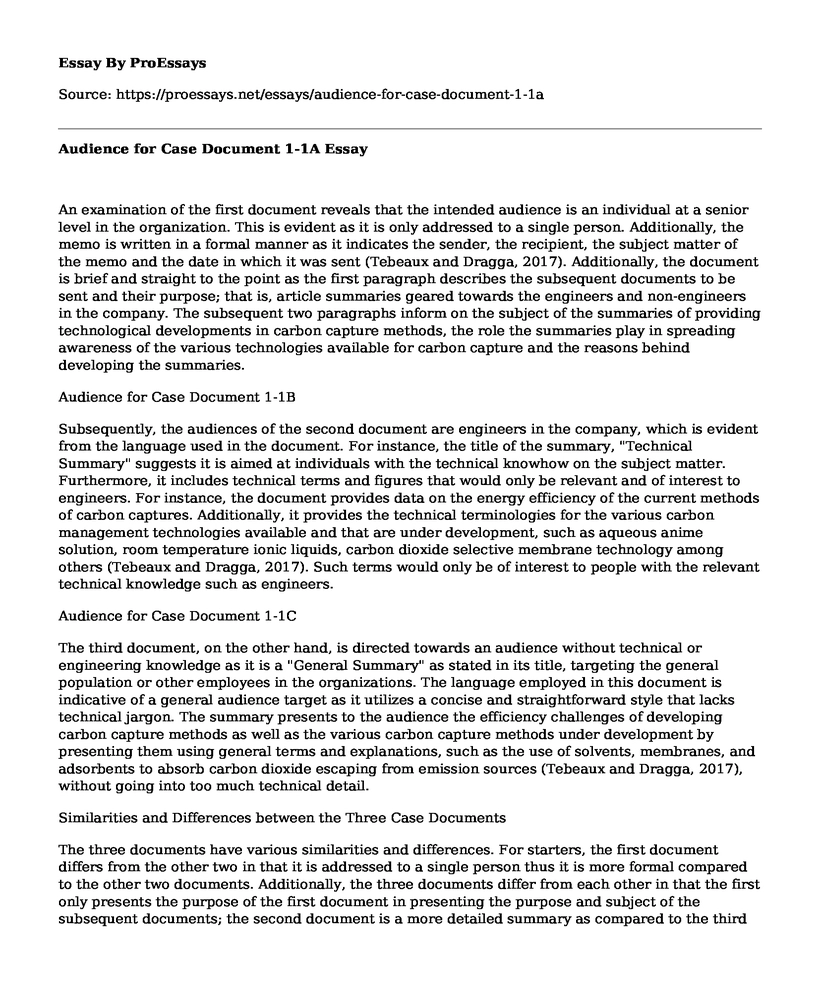An examination of the first document reveals that the intended audience is an individual at a senior level in the organization. This is evident as it is only addressed to a single person. Additionally, the memo is written in a formal manner as it indicates the sender, the recipient, the subject matter of the memo and the date in which it was sent (Tebeaux and Dragga, 2017). Additionally, the document is brief and straight to the point as the first paragraph describes the subsequent documents to be sent and their purpose; that is, article summaries geared towards the engineers and non-engineers in the company. The subsequent two paragraphs inform on the subject of the summaries of providing technological developments in carbon capture methods, the role the summaries play in spreading awareness of the various technologies available for carbon capture and the reasons behind developing the summaries.
Audience for Case Document 1-1B
Subsequently, the audiences of the second document are engineers in the company, which is evident from the language used in the document. For instance, the title of the summary, "Technical Summary" suggests it is aimed at individuals with the technical knowhow on the subject matter. Furthermore, it includes technical terms and figures that would only be relevant and of interest to engineers. For instance, the document provides data on the energy efficiency of the current methods of carbon captures. Additionally, it provides the technical terminologies for the various carbon management technologies available and that are under development, such as aqueous anime solution, room temperature ionic liquids, carbon dioxide selective membrane technology among others (Tebeaux and Dragga, 2017). Such terms would only be of interest to people with the relevant technical knowledge such as engineers.
Audience for Case Document 1-1C
The third document, on the other hand, is directed towards an audience without technical or engineering knowledge as it is a "General Summary" as stated in its title, targeting the general population or other employees in the organizations. The language employed in this document is indicative of a general audience target as it utilizes a concise and straightforward style that lacks technical jargon. The summary presents to the audience the efficiency challenges of developing carbon capture methods as well as the various carbon capture methods under development by presenting them using general terms and explanations, such as the use of solvents, membranes, and adsorbents to absorb carbon dioxide escaping from emission sources (Tebeaux and Dragga, 2017), without going into too much technical detail.
Similarities and Differences between the Three Case Documents
The three documents have various similarities and differences. For starters, the first document differs from the other two in that it is addressed to a single person thus it is more formal compared to the other two documents. Additionally, the three documents differ from each other in that the first only presents the purpose of the first document in presenting the purpose and subject of the subsequent documents; the second document is a more detailed summary as compared to the third document which is a general summary of an article on carbon management technologies.
On the other hand, the three documents share similarities associated with the qualities of good technical writing. For instances, the documents are neat, inviting, well organized and readable in that they are designed and written in a method that reveals the purpose of each document through the use of subheadings for the various sections. The use of subtitles in the articles also allows the writer to presents his ideas in a logical sequence and also ensures that the article summaries, as well as the transmittal memo, can be read selectively. Ultimately, the documents do not have any spelling mistakes or grammatical errors that may distract the reader from the main points.
Reference
Tebeaux, E., & Dragga, S. (2017). The Qualities of Good Technical Writing. In E. Tebeaux, & S. Dragga, The Essentials of Technical Communication (pp. 9-12). Oxford: Oxford University Press.
Cite this page
Audience for Case Document 1-1A. (2022, Nov 14). Retrieved from https://proessays.net/essays/audience-for-case-document-1-1a
If you are the original author of this essay and no longer wish to have it published on the ProEssays website, please click below to request its removal:
- Democracy Between 1865 and 1930s
- Apple Price Question Essay
- Team Structures: Enhancing Creativity and Innovation for Market Success - Essay Sample
- Essay Sample on Adapting Sales and Service Models for Changing Needs and Higher Expectations
- Essay Example on Improving Hospital Food Quality: A Business Case Study
- Paper Example on Struggle for Power & Supremacy: Who's Ahead?
- Implementing Policy in the Health Care System







